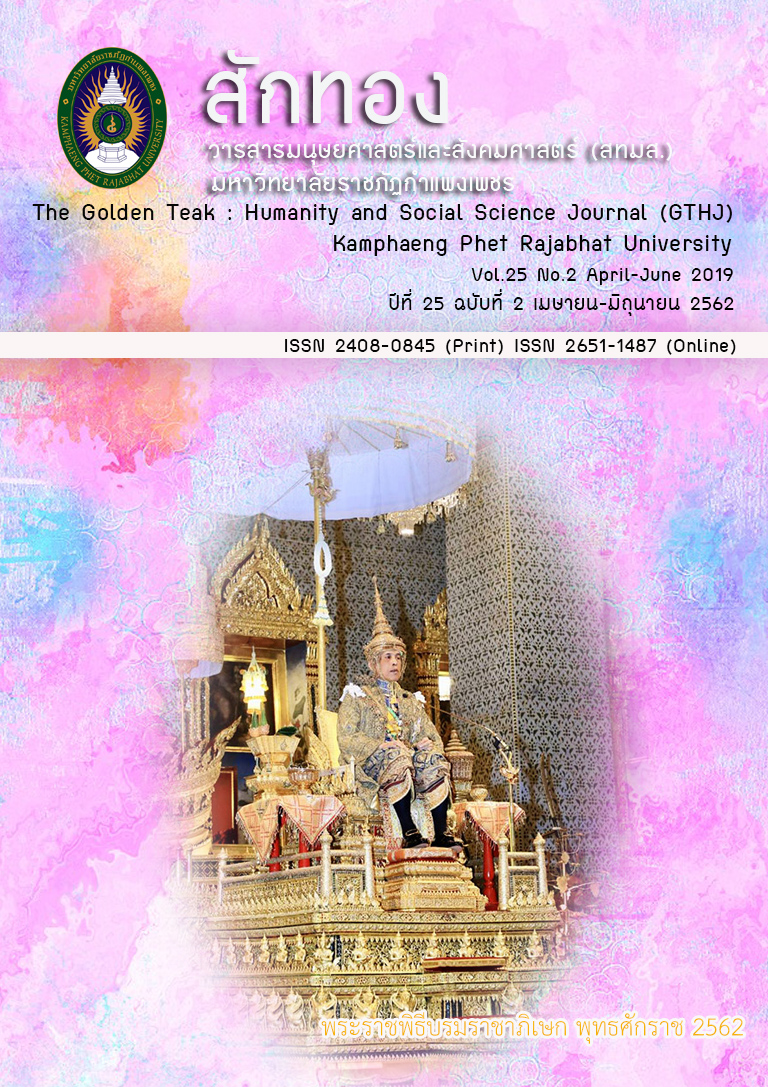Burned area extraction using multitemporal difference of spectral indices from Landsat 8 data: A case study of Khlong Wang Chao, Klong Lan and Mae Wong National Park
Main Article Content
Abstract
This study aimed to extract and evaluate burned areas in three national parks included
Khlong Wang Chao, Khlong Lan and Mae Wong National Park in year 2016 and 2017. Using multitemporal difference of spectral indices method based on the Landsat 8 OLI/TIRS data application and validate of those burned area results. The process consists of (1) prepare and import of satellite data by Burned Area Mapping Software (BAMS), (2) extract burned area using multitemporal difference of spectral indices method, (3) evaluate burned area in each park with Geographic Information System (GIS), and (4) analyzed the accuracy of results with visual analysis reference points. The results showed that 5 equations of indices include Normalized Difference Vegetation Index (NDVI), Burned Area Index Modified (BAIM), Global Environment Monitoring Index (GEMI), Normalized Burn Ratio (NBR), and Mid-Infrared Burned Index (MIRBI) and the difference of spectral indices as pre-fire date and post-fire date, can be used to set threshold values for burned areas classifying both small and large patches. The assessment of burned areas in Khlong Wang Chao, Khlong Lan and Mae Wong National Park found that burned area in 2016 were 24.44 km2, 11.48 km2, 24.08 km2, in the same way in 2017 were 12.49 km2, 6.97 km2, 5.84 km2, respectively. The accuracy assessment of burned areas in three national parks of both years compared with 203 reference points. The analysis found that overall accuracy were 96.06% and 96.55% and kappa hat coefficients were 0.85 and 0.87, respectively.
Article Details
บทความที่ได้รับการตีพิมพ์เป็นลิขสิทธิ์ของวารสาร สักทอง : วารสารมนุษยศาสตร์และสังคมศาสตร์ สถาบันวิจัยและพัฒนา มหาวิทยาลับราชภัฏกำแพงเพชร
ข้อคิดเห็นใดๆ ที่ปรากฎในวารสารเป็นวรรณกรรมของผู้เขียนโดยเฉพาะ ซึ่งมหาวิทยาลัยราชภัฏกำแพงเพชรและบรรณาธิการไม่จำเป็นต้องเห็นด้วย
References
Office, Royal Forest Department.
Bastarrika, A. (2014). Burned Area Mapping Software (BAMS) preliminary documentation.
University of Basque Country.
Bastarrika, A., Chuvieco, E., & Martín, P. (2011). Mapping burned areas from Landsat TM/ETM+ data with a two-phase algorithm : Balancing omission and commission errors. Remote
Sensing of Environment, 115, 1003-1012.
Bastarrika, A., et al. (2014). BAMS: A Tool for Supervised Burned Area Mapping Using Landsat
Data. Remote Sensing of Environment, 6(12), 12360-12380.
Chander, G., Markham, B., & Helder, D. (2009). Summary of Current Radiometric Calibration
Coefficients for Landsat MSS, TM, ETM+, and EO-1 ALI Sensors. Remote Sensing of
Environment, 113, 893–903.
Chuvieco, E., Martín, M. P., & Palacios, A. (2002). Assessment of different spectral indices in
the red-near-infrared spectral domain for burned land discrimination. International
Journal of Remote Sensing, 23(23), 5103-5110.
Gerard, F., et al. (2003). Forest fire scar detection in the boreal forest with multitemporal
SPOT-VEGETATION data. IEEE Transactions on Geoscience and Remote Sensing, 41
(11), 2575−2585. (Quoted by George et al., 2006)
Holden, Z. A., et al. (2005). Evaluation of novel thermally enhanced spectral indices for
mapping fire perimeters and comparisons with fire atlas data. International Journal
of Remote Sensing, 26(21), 4801-4808.
Huete, A. R. (1988). A soil-adjusted vegetation index (SAVI). Remote Sensing of Environment,
25(3), 295-309.
Huete, A. R., et al. (2002). Overview of the radiometric and biophysical performance of the
MODIS vegetation indices. Remote Sensing of Environment, 83, 195-213.
Jensen, J. R. (2005). Introductory Digital Image Processing: A Remote Sensing Perspective.
(3 rd ed). PracticeHall.
Key, C., & Benson, N. (2005). Landscape assessment: Ground measure of severity; The
Composite Burn Index, and remote sensing of severity, the Normalized Burn Index. In
D. Lutes, R. Keane, J. Caratti, C. Key, N. Benson, S. Sutherland and L. Gangi (Eds.),
FIREMON : Fire Effects Monitoring and Inventory System. USA : Rocky Mountains
Research Station, USDA Forest Service: Fort Collins.
Martín, P., Gómez, I., & Chuvieco, E. (2005). Performance of a burned-area index (BAIM)
for mapping Mediterranean burned scars from MODIS data. Paper presented at
the Proceedings of the 5 th International Workshop on Remote Sensing and GIS
Applications to Forest Fire Management: Fire Effects Assessment.
Pinty, B., & Verstraete, M. (1992). GEMI-A nonlinear index to monitor global vegetation from
satellites. Vegetatio, 101, 15-20.
Qi, J., et al. (1994). A modified soil adjusted vegetation index. Remote Sensing of
Environment, 48, 119-126.
Rouse, J. W., et al. (1974). Monitoring the vernal advancement and retrogradation
(Greenwave effect) of natural vegetation. Greenbelt, MD. USA : NASA/GSFC.
Ruthamnong, S. (2016). Optimal burned area and fire detection algorithms using Modis
and Landsat data: case study of upper northern region, Thailand. Ph.D.
(Geomatics). Suranaree University of Technology.
Ruthamnong, S. (2017). Spatial Distribution of Burned Area and MODIS Hotspot in
Chiang Mai Province, Thailand. 1st International Conference on Mechanical,
Electrical and Medical Intelligent System (ICMEMIS 2017). 29,30 Nov & 1
Dec, 2017. Japan : Kiryu.
Ruthamnong, S. & Ongsomwang, S. (2017). Burned Area Assessment Using BAMS : A
Case Study of Upper Northern Region, Thailand. Suranaree J. Sci. Technol,
24 (3), 327-342.
Smith, A. M. S., et al. (2007). Production of Landsat ETM+ reference imagery of burned areas
within Southern African savannahs: comparison of methods and application to MODIS. International Journal of Remote Sensing, 28(12), 2753-2775.
Trigg, S. & Flasse, S. (2001). An evaluation of different bi-spectral spaces for discriminating
burned shrub-savannah. International Journal of Remote Sensing, 22(13), 2641-
2647.
Tucker, C. (1979). Red and photographic infrared linear combinations for monitoring vegetation.
Remote Sensing of Environment, 8, 127-150.
USGS. (2016). Landsat Download Earth Explorer. [Online]. Available : https://earthexplorer.
usgs.gov/. [2016, April 28].
Veraverbeke, S., Harris, S. & Hook, S. (2011). Evaluating spectral indices for burned area
discrimination using MODIS/ASTER (MASTER) airborne simulator data. Remote Sensing
of Environment, 115(10), 2702-2709.


